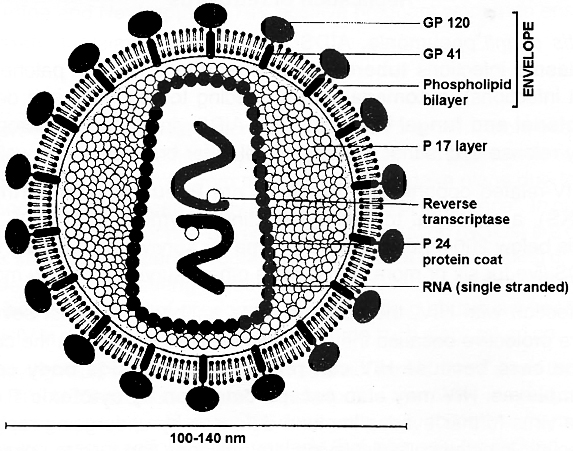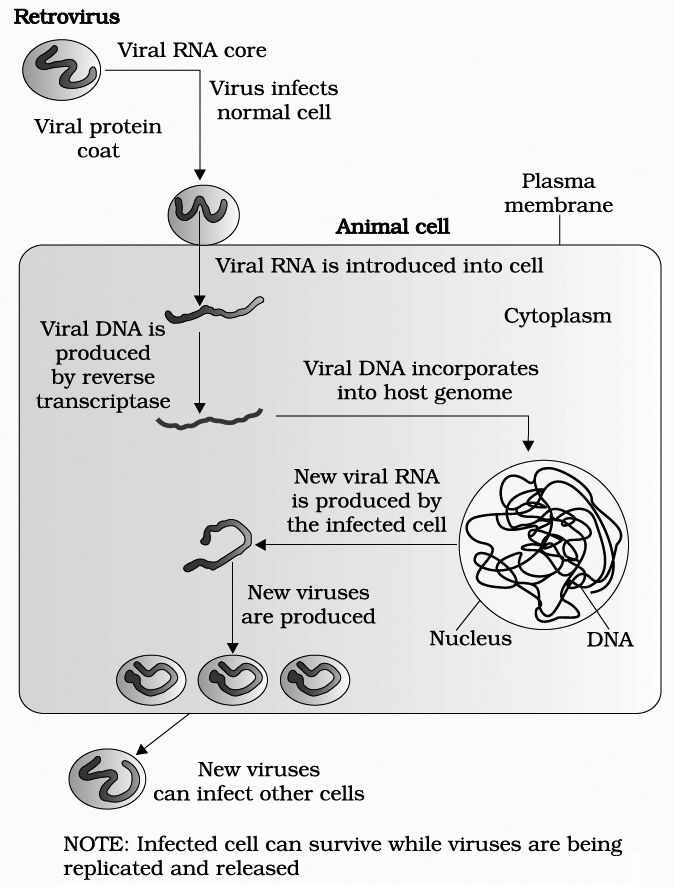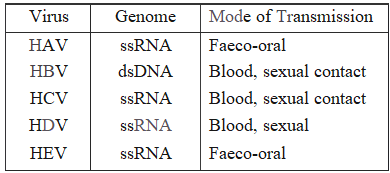- Books Name
- A TEXT OF BIOLOGY - CLASS XII
- Publication
- ACME SMART PUBLICATION
- Course
- CBSE Class 12
- Subject
- Biology
AIDS
AIDS (Acquired Immune Deficiency Syndrome) is a deadly disease, caused by HIV (human immunodeficiency virus), which mounts a direct attack on all cells that have a specific protein called CD4 on their surfaces.
CD4 is found on a class of lymphocyte cells called T4-cells.
This class includes Helper T-cells, which is why HIV destroys the body's population of Helper T-cells.
CD4 receptors are also found on macrophage surfaces, and as a result, macrophages also become infected with HIV.
Much of the HIV transmission from one individual to another is thought to occur within macrophages passed as part of body fluids.
Macrophages thus act as HIV factory.
A simplified definition of AIDS includes anyone infected with HIV and having a T4 lymphocyte count under 200/mm3 of blood. (Normally, the T4 count would be about 1200/mm3).
AIDS was first recognized in June 1981 as a result of reports from the Los Angeles area (U.S.A.) to the Center for Disease Control and Prevention (CDC) of several cases of a very rare type of pneumonia caused by a fungus.
The pneumonia, called Pneumocystis carinii pneumonia (PCP), occurred among homosexual males.
At about the same time, the CDC also received reports from New York and Los Angeles concerning an increase in the incidence of Kaposi's sarcoma (KS) amongst homosexual males.
AIDS was first recognised in USA in 1981.
In 1984, American and French scientists independently identified the agent as a virus.
The Americans named it HCLV-III (Human Cell Leukaemia Virus-III).
The name human immune deficiency virus is now preferred.
There are two types of HIV namely HIV-1 and HIV-2; the most common virus currently associated with AIDS is HIV-1.
A virus found in the blood of wild African green monkey, called the Simian immonodeficiency virus (SIV), is similar to HIV-2.
The genome of HIV consists of two indentical molecules of single stranded RNA and is said to be diploid.
HIV consists of a core RNA with Reverse Transcriptase surrounded by a protein coat.
The protein coat around the core consists of a protein called P24.
Outside this protein coat is a layer composed of another protein called P17.
The outermost envelope consists of a phospholipid bilayer studded with glycoproteins (GP120 and GP41).
HIV is a retrovirus; using the enzyme reverse transcriptase, it can synthesize DNA from RNA.
Once HIV produces DNA from its RNA, the DNA is integrated into the host cell's DNA.
There it can remain dormant, giving no sign of its presence, or it can take over the host cell's genetic machinery to produce more viruses.
The major cell infected by HIV is the Helper T-Iymphocyte that bears the CD4 receptors site.
The attachment of virus of CD4 receptor site is by the help of GP120 on the protein coat of the virus.
HIV enters body cells by receptor-mediated endocytosis.
The receptor of docking protein that permits HIV entry is the CD4 molecule on the surface of T4 cells, although other cellular factors, not yet understood, must also contribute.

With time, the number of T4 cells, mainly Helper T cells, declines due to death of infected cells.
The result is progressive collapse of the immune system.
Since cytokines secreted by Helper T cells normally stimulate the activity of monocytes, neutrophils, and macrophages, nonspecific defense mechanisms also are depressed.
The person becomes susceptible to opportunistic infections, invasion of normally harmless microorganisms that now proliferate wildly because of the defective immune system.

Besides Pneumocysfis carinii pneumonia, AIDS victims have persistent diarrhoea and are especially susceptible to Toxoplasma infections tuberculosis, leukoplakia (whitish patches on mucous membranes primarily due to yeast infections), cytomegalovirus (leading to blindness and dementia), Herpes simplex, among may other bacterial and fungal infections.
The AIDS virus infects macrophages, brain cells (where HIV-infected cells may release toxins that disrupt and kill other brain cells), as well as T4 cells.
The most common HIV-related opportunistic infections are Pneumocystis carinii pneumonia (PCP) and Kaposi's sarcoma (KS), a cancer of the skin.
The clinical symptoms of AIDS usually appear when the T-Iymphocyte level falls below 200/mm3.
The median time for survival after a diagnosis of AIDS is two years.
Some people with AIDS live for six or more years, while others survive for a few months only.
Some weeks after infection with HIV, the host develops antibodies against several proteins in the virus.
Antibodies normally are protective because they help eliminate an intruder.
In the case of the AIDS virus, this is not necessarily the case because HIV can remain hidden inside body cells, unavailable to form antigen-antibody complexes.
HIV may also escape detection by cytotoxic T cells, natural killer cells, and phagocytes.
The virus further evades immune defenses by undergoing rapid antigenic changes in its surface proteins.
Moreover, infected cells displaying viral acntigens can fuse to uninfected cells and spread the virus that way.
In rare cases, a person may harbor HIV without forming antibodies against it.
Thus, a standard blood test that detects antibodies would be negative.
The presence of nucleic acids from HIV can still be detected using a method called the polymerase chain reaction (PCR).
Once the host is infected by HIV, a detectable antibody response occurs in most cases within 6-8 weeks.
HIV antibodies can be detected by the ELISA test (enzyme-linked immunosorbent assay).
A positive ELISA should be confirmed using another test called the Western blot test.
Although HIV has been isolated from several body fluids, the only documented transmissions are from blood, semen, or vaginal secretions or by way of breast milk from a nursing mother to her baby.
The virus is found free and in macrophages in these fluids.
HIV is transmitted by sexual contact most commonly.
HIV is also effectively transmitted through exchanges of blood, for example, by contaminated hypodermic needles, contact with open wounds, or using the same razor blade for shaving.
Infected mothers may transmit the virus to their infants before or during birth.
It does not appear that people become infected as a result of routine nonsexual contact.
There is no known case of transmission from a mosquito bite.
It also appear that health-care personnel who take proper routine barrier precautions when dealing with body fluids (gloves, masks, safety glasses) are not at risk unless the barriers fail.
Outside the body, HIV is fragile and can easily be eliminated.
For example, dishwashing and clotheswashing, by exposing the virus to 135°F (56°C) for 10 minutes, will kill HIV.
Chemicals such as hydrogen peroxide (H2O2), rubbing alcohol, household bleach, and germicidal skin cleaner (such as Dettol) are also very effective, as is standard chlorination in swimming pools and hot tubs.
Medical scientists are engaged in an immense effort to find a cure for AIDS.
One of the problems in treating AIDS is that HIV can lie undetected in body cells.
In addition, HIV can infect a variety of cells, including those in the central nervous system that are protected by the blood-brain barrier.
Added to this is the problem of opportunistic infections, which may be very difficult to treat.
Any therapy must overcome the problem that antiviral agents may also harm host cells.
Thus scientists are trying to devise strategies for disrupting specific viral activities.
Some research centers on preventing binding of the virus to the host CD4 protein.
Other strategies are to prevent conversion of RNA to DNA, which is catalyzed by reverse transcriptase, block processing of viral proteins by specific viral enzymes, inhibit assembly of viruses within the host cell, and thwart release of new viruses.
To date, four drugs with similar action are used to inhibit HIV replication and slow the progression of AIDS.
All are nucleoside analogs, substances that are similar to the naturally occurring nucleosides in RNA and DNA.
They block conversion of retroviral RNA into DNA.
The first and still most commonly used drug to treat AIDS is AZT (azidothymidine) or Retrovir.
Among patients taking AZT, there is a slowing in the progression of symptoms.
The main side effects are red bone marrow damage and anemia.
Eventually, the virus develops resistance to the drug.
Other drugs are DDI (dideoxyinosine), DDC (dideoxycytidine), and D4T (stavudine), which may be used in patients who do not respond to AZT or have become resistant to it.
Doctors generally give Zidovudine and Nevirapine to HIV positive pregnant woman to ensure that their babies do not carry the infection.
Prevention of AIDS
As AIDS has no cure, prevention is the best option.
Moreover, HIV infection, more often, spreads due to conscious behaviour patterns and is not something that happens inadvertently, like pneumonia or typhoid.
Of course, infection in blood transfusion patients, new-borns (from mother) etc., may take place due to poor monitoring.
The only excuse may be ignorance and it has been rightly said -"don't die of ignorance".
In our country the National AIDS Control Organisation (NACO) and other non-governmental organisation (NGOs) are doing a lot to educate people about AIDS.
WHO has started a number of programmes to prevent the spreading of HIV infection.
Making blood (from blood banks) safe from HIV, ensuring the use of only disposable needles and syringes in public and private hospitals and clinics, free distribution of condoms, controlling drug abuse, advocating safe sex and promoting regular check-ups for HIV in susceptible populations, are some such steps taken up.
Infection with HIV or having AIDS is something that should not be hidden -since then, the infection may spread to many more people.
HIV/AIDS-infected people need help and sympathy instead of being shunned by society.
Unless society recognises it as a problem to be dealt with in a collective manner -the chances of wider spread of the disease increase manifold.
It is a malady that can only be tackled, by the society and medical fraternity acting together, to prevent the spread of the disease.
Cirrhosis
Cirrhosis refers to a distorted or scarred liver as a result of chronic inflammation.
The parenchymal (functional) hepatocytes are replaced by fibrous or adipose connective tissue.
The symptoms of cirrhosis include jaundice, edema in the legs, uncontrolled bleeding, and increased sensitivity to drugs.
Cirrhosis may be caused by hepatitis (inflammation of the liver), certain chemicals that destroy hepatocytes, parasites that infect the liver, and alcoholism.
HEPATITIS
1. Hepatitis refers to inflammation of the liver and can be caused by viruses, drugs, and chemicals, including alcohol. Clinically, several viral types are recognized. Hepatitis A (infectious hepatitis) is caused by hepatitis A virus and is spread by faecal contamination of food, clothing, toys, eating utensils, and so forth (faeco-oral route). It is generally a mild disease of children and young adults characterized by anorexia (loss of appetite), malaise, nausea, diarrhoea, fever, and chills. Eventually jaundice appears. Most people recover in 4-6 weeks. Hepatitis A virus has single-stranded RNA genome and non-enveloped capsid.
2. Hepatitis B (serum hepatitis) is caused by hepatitis B virus. HBV is a 42 nm enveloped virion, containing partially double-stranded circular DNA genome. Within the core there is DNA-dependent DNA polymerase. It is spread primarily by sexual contact and contaminated syringes and transfusion equipment. It can also be spread by saliva and tears. Hepatitis B virus can be present for years or even a lifetime and can produce cirrhosis and possibly cancer of the liver. Persons who harbor the active hepatitis B virus are at risk for cirrhosis and also become carriers. Vaccines produced through recombinant DNA technology (for example, Recombivax HB) are available to prevent hepatitis B infection. This vaccine is second generation vaccine.
3. Hepatitis C (non-A, non-B hepatitis) is caused by hepatitis C virus. It is clinically similar to hepatitis B and is often spread by blood transfusions. Hepatitis C can cause cirrhosis and possibly liver cancer. It has enveloped virion with ss-RNA.
4. Hepatitis D (delta hepatitis) is caused by hepatitis D virus which has ss-RNA. It is transmitted like hepatitis B. In fact, a person must be coinfected with hepatitis B before contracting hepatitis D. Hepatitis D results in severe liver damage and has a fatality rate higher than that of people infected with hepatitis B virus alone. HDV is a defective virus for which HBV is the helper.
5. Hepatitis E (infectious NANB hepatitis) is caused by hepatitis E virus and is spread like hepatitis A. Although it does not cause chronic liver disease, hepatitis E virus is responsible for a very high mortality rate in pregnant women. HEV has ss-RNA.
Table : Important properties of Hepatitis Virus

MENTAL HEALTH
Mental illness is characterised by the following symptoms: (i) depression, (ii) insomnia (lack of sleep) or excessive sleeping, (iii) compulsive actions, (iv) feeling of hopelessness, (v) serious thoughts of suicide, (vi) unreasonable phobias, (vii) partial or complete loss of memory, (viii) self-destructive behaviour, e.g., excessive gambling, drinking, drug abuse, over-eating and extreme dieting, (ix) delusions (false beliefs) and hallucinations, and (x) vocational and social dysfunctioning on a day-to-day basis.
Hallucination is a subjective disorder of sensory perception, in which one of the senses is involved in the absence of external stimulations.
Psychological Disorders
These include psychosis and neurosis, Psychosis involves deeper mental disorientation due to a distorted sense of reality.
Neurosis, on the other hand, is a maladaptive habit.
Neurotic individual relates to the same "real world" as does the normal, but cannot effectively act upon it. Important psychological disorders are as follows:
(i) Anxiety disorders: It is associated with a range of unpleasant bodily symptoms, including palpitation, sweating, nausea, trembling, diarrhoea and muscular tension.
(ii) Obsessive-compulsive disorders: These disorders cause total disability and affect a person's waking hours. Affected persons manifest overwhelming obsessions and compulsions. They are compelled to perform an action or an idea despite their own attempt to resist it (compulsion) . The most common obsessions are violence, concern about infection by germs or dirt, and constant doubts (obsessions).
(iii) Attention deficit disorder: It is a mental health problem among children. It occurs more in boys than in girls. As a result of this disorder, the boys exhibit under achievement, behavioural problems and a tendency to be disliked by other children.
(iv) Mood disorders: These are the occasional bouts of high or low mood, i.e., elation and depression. Depression is a mood disorder characterised by sadness, hopelessness, low self-esteem, decline in interest, energy, concentration and changes in sleep pattern and appetite.
(v) Schizophrenia: It is characterised by (a) distorted thoughts (b) laughing or crying at completely inappropriate times (c) often disturbed emotions with rapid shifts from one extreme response to other, and (d) incoherent and bizarre behaviour lasting for a week or more. Schizophrenic may also suffer from delusions, auditory hallucinations and can find difficulty in handling even the simplest jobs.
(vi) Borderline personality disorder (BPD) : This disorder is an emotionally unstable personality disorder, which is characterised by impulsivity, unpredictable moods, outbursts of emotion, behavioural explosions, quarrelsome behaviour, and conflicts with others. BPD can be diagnosed with specific patterns of behavioural, emotional, and cognitive instability and dysregulations. These individuals are highly reactive, and generally experience episodic depression, anxiety, and irritability. They also have problems with anger and anger expression. Relationships with other individuals are chaotic, intense, but nevertheless, hard to give up. Individuals with BPD often attempt to injure, multilate, or kill themselves, and have little sense of self since they feel empty.

 ACME SMART PUBLICATION
ACME SMART PUBLICATION
